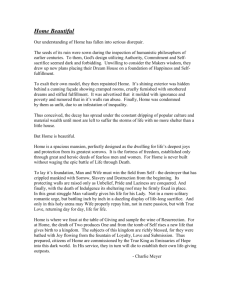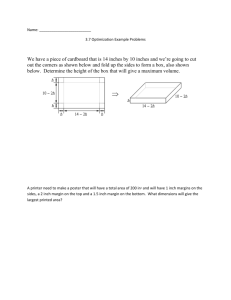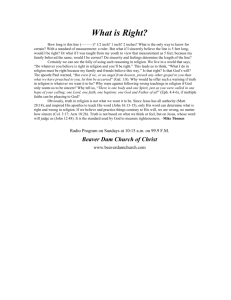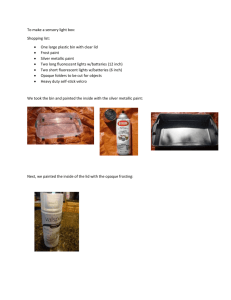Labcap - Nanolab
advertisement
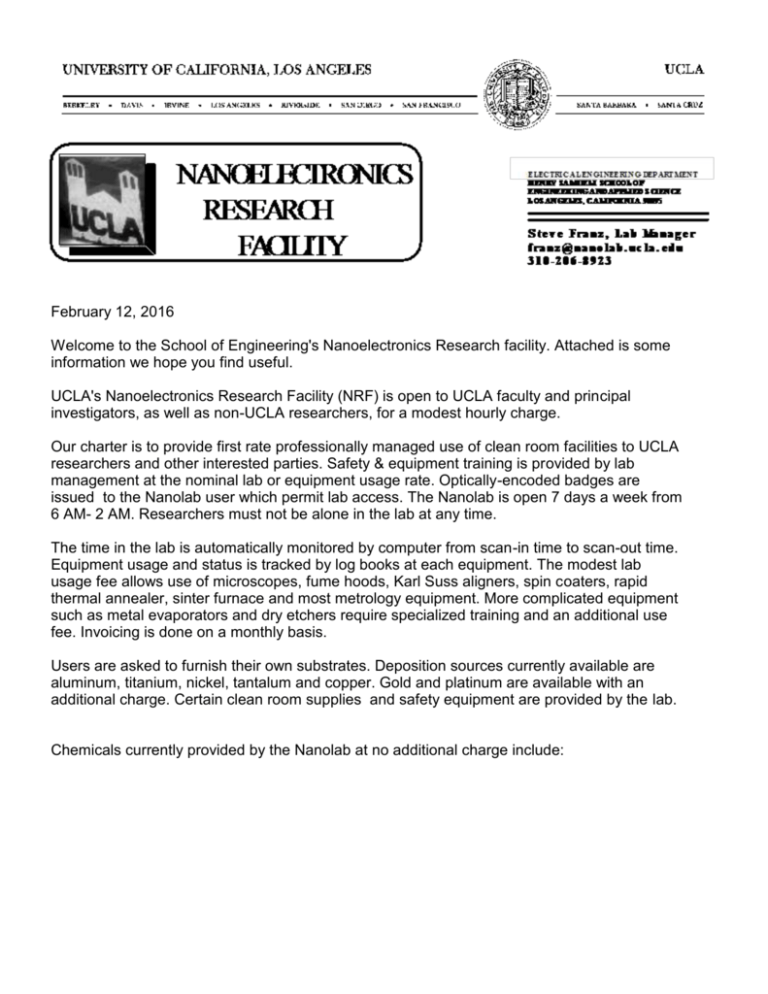
February 12, 2016 Welcome to the School of Engineering's Nanoelectronics Research facility. Attached is some information we hope you find useful. UCLA's Nanoelectronics Research Facility (NRF) is open to UCLA faculty and principal investigators, as well as non-UCLA researchers, for a modest hourly charge. Our charter is to provide first rate professionally managed use of clean room facilities to UCLA researchers and other interested parties. Safety & equipment training is provided by lab management at the nominal lab or equipment usage rate. Optically-encoded badges are issued to the Nanolab user which permit lab access. The Nanolab is open 7 days a week from 6 AM- 2 AM. Researchers must not be alone in the lab at any time. The time in the lab is automatically monitored by computer from scan-in time to scan-out time. Equipment usage and status is tracked by log books at each equipment. The modest lab usage fee allows use of microscopes, fume hoods, Karl Suss aligners, spin coaters, rapid thermal annealer, sinter furnace and most metrology equipment. More complicated equipment such as metal evaporators and dry etchers require specialized training and an additional use fee. Invoicing is done on a monthly basis. Users are asked to furnish their own substrates. Deposition sources currently available are aluminum, titanium, nickel, tantalum and copper. Gold and platinum are available with an additional charge. Certain clean room supplies and safety equipment are provided by the lab. Chemicals currently provided by the Nanolab at no additional charge include: Acetone Ammonium Hydroxide AZ400K Developer AZ Developer SU 8 Developer Oleg 355 Stripper AZ5214E Resist AZ4620 Photoresist Buffered Oxide Etch (6:1) Hydrofluoric Acid HBr HMDS Nanostrip Hydrochloric Acid Hydrogen Peroxide Isoproponol Methanol Phosphoric Acid Nitric Acid Sulfuric Acid The following pages outline UCLA's Nanoelectronics Research Facility's process capability. You can visit our website for more information: http://nanolab.ucla.edu. Thank you again for your interest. Nanoelectronics Research Facility Director: Nanoelectronics Research Facility Manager: Prof. Jack Judy, Electrical Engineering Steve Franz NANOELECTRONIC RESEARCH FACILITY CAPABILITY LITHOGRAPHY • Leica EBL100 Nanowriter e-beam patterning system with 100 Kev beam and lasercontrolled stage with resolution down to 30 nm. • 2 Karl Suss MA6 top and bottom side aligners for contact printing (Vacuum, hard and soft contact and proximity modes are supported.) Mask plates from 3.5-7 inch and substrate sizes from 1 cm square to 4 inch can be accommodated. Resolution in thin film resists down to .9 micron can be achieved. The newer machine can also do bond-alignment. • Karl Suss SB6 bonder capable of pieces or 4 inch substrates for anodic or thermocompression bonding with programmable temperature, force and voltage. • 2 Headway programmable spinner capable of up to 6 inch substrates with speed control down to 100 RPM for thick resist and ramp control for stress reduction. • Miscellaneous bake ovens with purge capability and temperatures to 250°C. • Miscellaneous programmable hot plates for baking and annealing. Ramped bakes are possible for materials such as SU 8. • High Temperature (up to 1000°C) nitrogen-purged muffle furnace for organic or spin-on film curing and hardening. ETCHING: • Plasma-Therm SLR 770 ICP deep silicon etcher with etch rates of 2-4 microns/minute and selectivities to resist and most hard masks >20:1. • Plasma-Therm SLR 770 ICP Cl etcher for aluminum and III-V etching with Cl2, BCL3, CH4 and HBr etch capability. Typical etch rates for GaAs and InP are up to 1 micron/minute. • Fluorine based Reactive Ion Etching for anisotropic etching of silicon dielectrics using Oxford 80 Plus and Technics Micro RIE 800. Typical etch rates for silicon dielectrics are ~1000 Ang/min. • STS AOE Advanced Oxide Etcher for deep etching (>50 microns) of oxide with high selectivity to resist and silicon and fast etch rate (>2200 Ang/min). Machine is also capable of anisotropic etching of ceramics. • Custom XeF2 vapor etcher for isotropic etching of silicon with high selectivity to resist, oxide and many other common materials used in microfabrication with piece or 4 inch wafer capability. Etch rates of up to 1 micron/minute are possible. • Oxygen plasma asher, barrel reactor type.(Tegal 421). NANOELECTRONIC RESEARCH FACILITY CAPABILITY ETCHING (cont’d): • Matrix 105 single wafer high rate, low damage downstream stripper with strip rates >1 micron per minute. • Logitech PM5 polisher/grinder for substrate thinning and polishing (pieces up to 4 inch). Semiconductors, glass and many metals may be polished or lapped. METALLIZATION: • CHA Mark 40, 6 pocket e-beam evaporator cryo pumped to mid E-8 range, with deposition rate control, 24-4 inch wafer rotating lift-off dome, and chamber heater. • 2nd CHA Mark 40, 6 pocket e-beam evaporator cryo pumped to mid E-8 range, with deposition rate control, 24-4 inch wafer rotating lift-off dome, and chamber heater. Also includes a swing out source with thermal evaporation capability and with reactive (oxygen) deposition capability. • E-beam evaporation : Al, Au, Ti etc.; 4 hearth, Sloan 1800 with substrate heat & rate thickness control, cryo-pumped to low E-7 range. • CVC 601: 3 target sputtering system (2 DC and 1 RF) with sputter etch capability. • Small SEM sputter coater (Denton II) for SEM thin film conductor deposition THERMAL PROCESSING and DEPOSITION: • RTP 610 capable of up to 6 inch substrates with either TC or Pyro closed-loop feedback and software (windows) controlled for dedicated Si processing . • RTP 650 capable of up to 6 inch substrates with either TC or Pyro closed-loop feedback and software (windows) controlled for dedicate III-V processing . • Dry & Wet oxidation and anneals up to 1100°C for up to 6 inch substrates . • LPCVD doped (phosphorus) or undoped polysilicon (600-620°C) for up to 6 inch substrates. • LPCVD silicon nitride (~780°C) using NH3 and SiCl2H2 reactions with low stress nitride capability up to 6 inch wafers. • LPCVD low temperature (~450°C) oxide, LTO for phosphorus doped or undoped films up to 6 inch wafers. • High temperature (1300 Deg C) clean furnace with O2/Ar capability for oxidation & anneals (6 inch wafer capable). NANOELECTRONIC RESEARCH FACILITY CAPABILITY THERMAL PROCESSING And DEPOSITION (cont’d): • Boron Nitride solid source doping process for p+ Si formation • Specialty Coating Systems’ 2010 Parylene vacuum deposition system PLASMA DEPOSITION: • PlasmaTherm 790 PECVD reactor for depositing low temperature (~300°C) films of silicon nitride, silicon oxide and amorphous silicon. • STS Multiplex CVD deposition system for high rate, low stress dielectric deposition with doped film capability (Phos). Deposition rates for oxide of >2000Ang/min Low stress nitride with stress<1E8dynes/cm2 can be deposited. Stress is controlled by frequency mixing. OTHER: • Tousimis 915B Supercritical Dryer capable of pieces up to 6 inch substrates using CO2/methanol mixture. • Porous Si etch bath with illumination and bias capability. METROLOGY: • Hitachi S-4700 cold field emission SEM with 6 inch automated stage and EDAX X-Ray elemental analysis capability. System has integrated backscatter detector and resolution down to 2.5 nm @ 1 KV and 1.5nm @ 15KV. • Dektak 8 Surface Profilometer with 100mm scan, extended vertical range to 1 mm, 3D analysis and stress measurement software. System can also use nanotips for profiling high aspect ratio structures • Dektak 6 Surface Profilometer with 100mm scan, and extended vertical range to 1mm for rapid profiling. • SCI Filmtek 2000 spectrophotometer for measuring thickness and refractive index of multiple films including SOI, porous silicon and III-V film stacks. • M&M probe station (6 inch wafer capable) connected to HP 4145 Parametric analyzer for low frequency device characterization. • Tencor Alpha Step 200 profilometer for measuring step heights from 100 Å to 160 µm. • Prometrix Omnimap RS-35 4 point probe for mapping sheet resistances. NANOELECTRONIC RESEARCH FACILITY CAPABILITY METROLOGY (cont’d): • 2 Nanospec 210 computers controlled Thin Film Measuring System Systems for measuring thin semitransparent films such as polyimide, photoresist, silicon dioxide, silicon nitride, polysilicon etc.. • Gaertner L116B automatic ellipsometer (632.8nm) with variable angle of incidence under Windows 95 control for measuring thickness and refractive index of very thin films. • Miscellaneous optical microscopes with variable magnification to 1000X and 3 Nikon Optiphot microscopes with DIC, dark field and bright field optics. • Digital imaging microscope for taking micrographs • Digital focussing microscope for measuring deep trenches or thick patterned films. • Flexus 2320A film stress measuring system. FACILITY: • 8000 Sq. ft class 1000 HEPA filtered clean room with an additional 500 sq. ft of class 100 space with temperature and humidity control. • Vibration-isolated floor, independently suspended from the building. • High Purity Deionized water system (18MΩ-cm) with filtration, UV bacteria removal etc. • High purity (5 9's) bulk nitrogen gas delivery system, filtered at point of use. • Full complement of utilities including chilled water, compressed air etc. • 500 sq ft yellow room for processing photosensitive materials. • 7 scrubber-exhausted fume hoods some with in deck temperature controlled baths, ultrasonic baths, automatic DI water dump rinsers etc. All fume hoods completely plumbed with high purity DI and high purity nitrogen. • Remote toxic gas bunker with automatic purge panel and orbital-welded stainless steel lines for safe handling of poisonous and pyrophoric gases. • In-situ, real-time toxic gas monitoring system NANOELECTRONIC RESEARCH FACILITY CAPABILITY MANAGEMENT: • Professional staff of 6 engineers and several student helpers with a combined experience of over 70 years in microelectronic fabrication. Lab manager experienced in running a bipolar/CMOS line in industry (TRW). • Fully documented procedures for every piece of equipment (www.nanolab.ucla.edu) • 2 stage training and log book system for accountability and tracking of equipment performance. • Entry badging system for lab use charging and tracking. • Online equipment reservation system for automated machine reservation (includes offsite users). • Monthly computer-aided invoicing system for internal and external users. Lab is run as a feebased recharge entity under auspices of the UC school system. • Monthly new user orientation and lab walkthrus (see the online calendar at www.nanolab.ucla.edu). • Semiannual faculty user meetings to capture user input on things such as future capability, operation procedures, recharge rates etc. Lab is user-driven.




